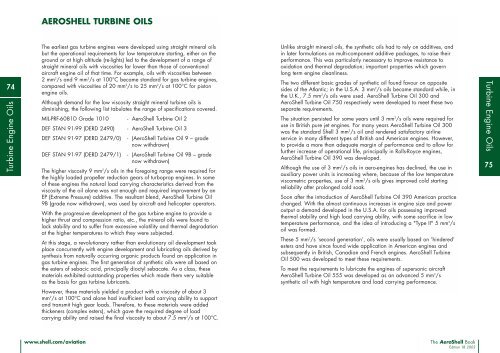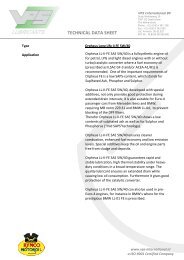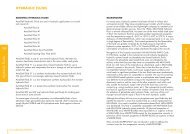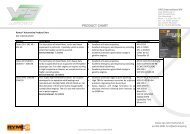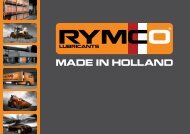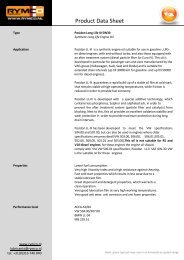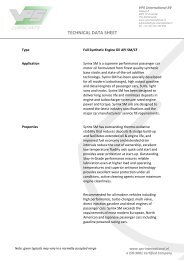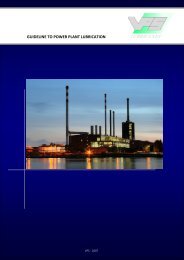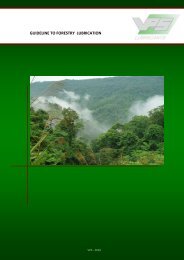Turbine Engine Oils - VPS Lubricants
Turbine Engine Oils - VPS Lubricants
Turbine Engine Oils - VPS Lubricants
Create successful ePaper yourself
Turn your PDF publications into a flip-book with our unique Google optimized e-Paper software.
AEROSHELL TURBINE OILS74<strong>Turbine</strong> <strong>Engine</strong> <strong>Oils</strong>The earliest gas turbine engines were developed using straight mineral oilsbut the operational requirements for low temperature starting, either on theground or at high altitude (re-lights) led to the development of a range ofstraight mineral oils with viscosities far lower than those of conventionalaircraft engine oil of that time. For example, oils with viscosities between2 mm 2 /s and 9 mm 2 /s at 100°C became standard for gas turbine engines,compared with viscosities of 20 mm 2 /s to 25 mm 2 /s at 100°C for pistonengine oils.Although demand for the low viscosity straight mineral turbine oils isdiminishing, the following list tabulates the range of specifications covered.MIL-PRF-6081D Grade 1010 - AeroShell <strong>Turbine</strong> Oil 2DEF STAN 91-99 (DERD 2490) - AeroShell <strong>Turbine</strong> Oil 3DEF STAN 91-97 (DERD 2479/0) - (AeroShell <strong>Turbine</strong> Oil 9 – gradenow withdrawn)DEF STAN 91-97 (DERD 2479/1) - (AeroShell <strong>Turbine</strong> Oil 9B – gradenow withdrawn)The higher viscosity 9 mm 2 /s oils in the foregoing range were required forthe highly loaded propeller reduction gears of turboprop engines. In someof these engines the natural load carrying characteristics derived from theviscosity of the oil alone was not enough and required improvement by anEP (Extreme Pressure) additive. The resultant blend, AeroShell <strong>Turbine</strong> Oil9B (grade now withdrawn), was used by aircraft and helicopter operators.With the progressive development of the gas turbine engine to provide ahigher thrust and compression ratio, etc., the mineral oils were found tolack stability and to suffer from excessive volatility and thermal degradationat the higher temperatures to which they were subjected.At this stage, a revolutionary rather than evolutionary oil development tookplace concurrently with engine development and lubricating oils derived bysynthesis from naturally occurring organic products found an application ingas turbine engines. The first generation of synthetic oils were all based onthe esters of sebacic acid, principally dioctyl sebacate. As a class, thesematerials exhibited outstanding properties which made them very suitableas the basis for gas turbine lubricants.However, these materials yielded a product with a viscosity of about 3mm 2 /s at 100°C and alone had insufficient load carrying ability to supportand transmit high gear loads. Therefore, to these materials were addedthickeners (complex esters), which gave the required degree of loadcarrying ability and raised the final viscosity to about 7.5 mm 2 /s at 100°C.Unlike straight mineral oils, the synthetic oils had to rely on additives, andin later formulations on multi-component additive packages, to raise theirperformance. This was particularly necessary to improve resistance tooxidation and thermal degradation; important properties which governlong term engine cleanliness.The two different basic grades of synthetic oil found favour on oppositesides of the Atlantic; in the U.S.A. 3 mm 2 /s oils became standard while, inthe U.K., 7.5 mm 2 /s oils were used. AeroShell <strong>Turbine</strong> Oil 300 andAeroShell <strong>Turbine</strong> Oil 750 respectively were developed to meet these twoseparate requirements.The situation persisted for some years until 3 mm 2 /s oils were required foruse in British pure jet engines. For many years AeroShell <strong>Turbine</strong> Oil 300was the standard Shell 3 mm 2 /s oil and rendered satisfactory airlineservice in many different types of British and American engines. However,to provide a more than adequate margin of performance and to allow forfurther increase of operational life, principally in Rolls-Royce engines,AeroShell <strong>Turbine</strong> Oil 390 was developed.Although the use of 3 mm 2 /s oils in aero-engines has declined, the use inauxiliary power units is increasing where, because of the low temperatureviscometric properties, use of 3 mm 2 /s oils gives improved cold startingreliability after prolonged cold soak.Soon after the introduction of AeroShell <strong>Turbine</strong> Oil 390 American practicechanged. With the almost continuous increases in engine size and poweroutput a demand developed in the U.S.A. for oils possessing improvedthermal stability and high load carrying ability, with some sacrifice in lowtemperature performance, and the idea of introducing a "Type II" 5 mm 2 /soil was formed.These 5 mm 2 /s ‘second generation’, oils were usually based on ‘hindered’esters and have since found wide application in American engines andsubsequently in British, Canadian and French engines. AeroShell <strong>Turbine</strong>Oil 500 was developed to meet these requirements.To meet the requirements to lubricate the engines of supersonic aircraftAeroShell <strong>Turbine</strong> Oil 555 was developed as an advanced 5 mm 2 /ssynthetic oil with high temperature and load carrying performance.<strong>Turbine</strong> <strong>Engine</strong> <strong>Oils</strong>75www.shell.com/aviationThe AeroShell BookEdition 18 2003
80<strong>Turbine</strong> <strong>Engine</strong> <strong>Oils</strong>As a general rule, Shell Companies do not make recommendationsregarding compatibility, since aviation applications are critical and thedegree of compatibility depends on the operating conditions, performancerequirements, and the exact composition of materials. In many cases theequipment manufacturers perform their own compatibility testing or havetheir elastomer supplier do it for them. Many elastomer suppliers doproduce tables showing the compatibility of their products with a range ofother materials. Therefore, the information provided here can only beconsidered as a guideline.Elastomer/Plastic Mineral <strong>Turbine</strong> Synthetic Ester<strong>Oils</strong><strong>Turbine</strong> <strong>Oils</strong>Fluorocarbon (Viton) Very good Very goodAcrylonitrile Good Poor to Good(high nitrile contentis better)Polyester Good Poor to FairSilicone Poor to Good Poor to FairTeflon Very Good Very goodNylon Poor to Good PoorBuna -S Poor PoorPerbunan Good Fair to GoodMethacrylate Good Poor to FairPAINTSEpoxy resin paints have been found to be practically the only paintsentirely compatible giving no breakdown or softening or staining in use,except for the very light colour shades, which are susceptible to stainingdue to the actual colour of the anti-oxidant inhibitor contained in practicallyall ester based lubricants.PLASTICSOnly the more common plastics can be considered for evaluation ofcompatibility.The best from chemical and physical aspects is polytetrafluoroethylene, asmight be expected from its generally inert properties. This is closelyfollowed by higher molecular weight nylon. Polyvinyl chloride is rapidlysoftened by the hot oil and is not recommended. Currently, polythene andterylene are also suspect in this respect, but have not been extensivelyevaluated.VARNISHESMany commonly used phenolic impregnated varnishes are softened bycontact with the hot oil, but a few of the harder grades show moderate togood resistance. Silicone varnishes and TS 188 are considerably softened.Modified alkyd type varnishes, when baked, possess good resistance to oilbut have poor resistance to water. When good resistance to water is alsorequired, it is recommended that the varnish be coated with a waterresistant finish.<strong>Turbine</strong> <strong>Engine</strong> <strong>Oils</strong>81Neoprene Fair to Good PoorMINERAL AND VEGETABLE OILSEster based synthetic oils are incompatible with mineral and vegetable oils.In no circumstances should these products be used together and, ifchanging from one type to another, then particular care is needed toensure that all traces of the previous product are removed prior to esterlubricant application.Natural Rubber Poor to Fair PoorPolyethylene Good GoodButyl Rubber Very Poor to Poor Poor to FairPoly Vinyl Chloride Poor to Good PoorMETALSCopper and alloys containing copperAs in mineral oil applications, pure copper has a marked catalytic effect atsustained high oil temperatures on the break down of the esters to acidderivatives, and its use in engines or other equipment is thus mostundesirable. Copper alloys such as brass and bronze do not possess thisproperty to any great degree and can be used with safety.Compatibility Rating:Very Good – Good – Fair – Poor – Very Poorwww.shell.com/aviationThe AeroShell BookEdition 18 2003
Aluminium and steel and their alloysThese materials are not affected.Nickel and alloys are generally satisfactory.Tin plating is generally satisfactory.For aircraft oil tanks the recommended material is light alloy or stainlesssteel.82<strong>Turbine</strong> <strong>Engine</strong> <strong>Oils</strong>CadmiumCadmium, in the form of plating as a protective treatment for storage ofparts destined to be in contact with oil in service, experiences a tendencyat the higher temperatures to be taken into solution by synthetic oils. Thissolvent action does not harm the lubricant, but the slow removal ofcadmium plating after many hours of service will detract from its efficiencyas a subsequent protective.Lead and alloys containing leadLead and all alloys containing lead are attacked by synthetic lubricants.The way the lubricant reacts with the lead differs according to the type oflubricant, but in general, all lead compounds should be avoided. The mostcommon forms of lead are lead abradable seals and lead solder usedparticularly in filters and mesh screens. In these cases the mesh screenshould be brazed.OTHER METALSMagnesium is not affected except where hydrolysis occurs. Thusmagnesium should not be used if there is any likelihood of hydrolysisoccurring or alternatively the magnesium could be coated with epoxy toprotect it.Monel and Inconel are not affected.Tungsten accumulates a very thin soft black film after prolongedimmersion in synthetic oils under static conditions. It is readily removed bywiping, leaving no sign of corrosion. Under the scrubbing conditionsnormally associated with circulatory oil systems this film does notmaterialise and its effect may be ignored.Zinc, as galvanised protective, is attacked by synthetic lubricants leadingto the formation of zinc soaps and thus should not be used. Storage ofsynthetic oils is best achieved in tinned mild steel cans or failing this, brightmild steel.Titanium is not affected.Silver and silver plating is generally not affected. However, in somesynthetic ester oils, the additive pack, especially high load additives, reactwith the silver and blacken or even de-plate the silver.Chromium plating is not affected.NON-AVIATION USE OF AEROSHELL TURBINE ENGINE OILSIn selecting an AeroShell turbine engine oil for a non-aviation application,the properties of the oil must be examined. This will only give anapproximate indication as to the expected performance in the specificapplication. However, such data must be regarded as guidance only. Thereis no laboratory test that can give a complete prediction of performance inactual use, and the final stage in any decision must involve performancetests in either the actual equipment or in the laboratory/test house underconditions expected in service.The main use of AeroShell turbine engine oils in non-aviation applicationsis in aero-derived industrial and marine gas turbine applications. Suchengines have found application in:- electrical power generation- large pumps and compressors, especially in pipeline applications and inpetrochemical process industry- marine propulsionIn an aero-engine, essential design features are it’s size and weight, whichresults in compact units. Such designs place heavy demands on the enginecomponents and lubricants to ensure total reliability in the hightemperatures within the engine.The land and sea based derivatives of the aero-engines retain the essentialdesign elements of their aviation versions and thus have similar lubricationrequirements. <strong>Engine</strong> manufacturers therefore approve the use of aircraftsynthetic turbine oils in these engines. Only these lubricants have thecharacteristics required to provide the unit lubrication and cooling withinthe severe operating environment.There is a full range of AeroShell turbine oils approved by the majorengine manufacturers for use in their industrial and marine derivatives ofaero-engines and a quick reference table is included at the end of thissection.<strong>Turbine</strong> <strong>Engine</strong> <strong>Oils</strong>83www.shell.com/aviationThe AeroShell BookEdition 18 2003
<strong>Turbine</strong> <strong>Engine</strong> <strong>Oils</strong>84SUMMARY OF AEROSHELL TURBINE OILSPECIFICATION APPROVALSwww.shell.com/aviationSpecification AEROSHELL TURBINE OIL CommentsNumber 308 390 500 529 531 555 560 750MIL-PRF-7808L U.S. Air ForceGrade 3 Approved — — — — — — — 3 mm 2 /s oil specificationGrade 4 — — — — — — — — 4 mm 2 /s oil specificationMIL-PRF-23699F U.S. Navy 5 mm 2 /sSTD — — Approved Approved — — — — oil specificationC/I — — — — Approved — — —HTS — — — — — — Approved —DOD-L-85734 — — — — — Approved — — U.S. helicoptertransmission specificationDEF STAN 91-93 — — — — — — — — U.K. 5 mm 2 /s Marine(DERD 2458) Gas <strong>Turbine</strong> oilspecificationDEF STAN 91-94 — Approved — — — — — — U.K. 3 mm 2 /s oil(DERD 2468) specificationDEF STAN 91-98 — — — — — — — Approved U.K. 7.5 mm 2 /s oil(DERD 2487) specificationDEF STAN 91-100 — — — — — Approved — — U.K. Advanced 5 mm 2 /s(DERD 2497) oil specificationDEF STAN 91-101 U.K. 5 mm 2 /s oil(DERD 2499) specificationGrade OX-27 — — Approved — — — — —Grade OX-28 — — — — — — — —NOTESThe AeroShell BookEdition 18 200385<strong>Turbine</strong> <strong>Engine</strong> <strong>Oils</strong>
AEROSHELL TURBINE OIL 286<strong>Turbine</strong> <strong>Engine</strong> <strong>Oils</strong>AeroShell <strong>Turbine</strong> Oil 2 is a 2 mm 2 /s mineral turbine oil blended frommineral base stocks to which a pour-point depressant and an anti-oxidanthave been added.APPLICATIONSAeroShell <strong>Turbine</strong> Oil 2 is widely used for inhibiting fuel systems and fuelsystem components during storage.AeroShell <strong>Turbine</strong> Oil 2 is an analogue to the Russian Grade MK-8 andcan therefore be used in engines which require the use of MK-8.SPECIFICATIONSU.S. Approved MIL - PRF - 6081D Grade 1010British –French Equivalent to AIR 3516/ARussianAnalogue to MK-8PROPERTIES MIL-PRF- 6081D TYPICALGrade 1010Oil type Mineral MineralDensity @ 15°C kg/l _ 0.875Kinematic viscosity mm 2 ⁄S@ 37.8°C 10.0 min 10.5@ −40°C 3000 max 2700Viscosity stability 3hrs@ −40°C 2 max 0.2Pourpoint °C −57 max Below −57Flashpoint ClevelandOpen Cup °C 132 min 154Total Acidity mgKOH/g 0.10 max 0.02<strong>Turbine</strong> <strong>Engine</strong> <strong>Oils</strong>87NATO Code O -133Colour ASTM 5.5 max
AEROSHELL TURBINE OIL 3SPAeroShell <strong>Turbine</strong> Oil 3SP is a 3 mm 2 /s mineral turbine oil incorporatingadditives to improve anti-wear and anti-oxidant properties as well as lowtemperature properties.SPECIFICATIONSU.S. –APPLICATIONSAeroShell <strong>Turbine</strong> Oil 3SP has excellent low temperature properties and isapproved for use in Russian engines which use the Russian grades MS-8P,MK-8P and MS-8RK. Typical civil applications include various models of theIl-62, Il-76, Il-86, Il-114, Tu-134, Tu-154, YAK-40, AN-12, AN-26, AN-30,and M-15 aircraft as well as the Mi-6 and Mi-10 helicopters. Typicalmilitary applications include the MiG-9, MiG-11, MiG-15, MiG-17,MiG-21, Su-7, Su-9, Su-11 and Su-15 aircraft.AeroShell <strong>Turbine</strong> Oil 3SP is approved for use in the preservation of oiland fuel systems where Russian grades MK-8, MS-8P and MS-8RK areused.AeroShell <strong>Turbine</strong> Oil 3SP can also be used in oil mixtures where this oil ismixed with piston engine oil. Typical mixtures are:SM-4.5 = 75% MS-8P + 25% MS-20 = 75% AeroShell <strong>Turbine</strong> Oil 3SP +25% AeroShell Oil 100SM-8.0 = 50% MS-8P + 50% MS-20 = 50% AeroShell <strong>Turbine</strong> Oil 3SP +50% AeroShell Oil 100SM-11.5 = 25% MS-8P + 75% MS-20 = 25% AeroShell <strong>Turbine</strong> Oil 3SP +75% AeroShell Oil 100British –90<strong>Turbine</strong> <strong>Engine</strong> <strong>Oils</strong>French –RussianNATO Code –Joint Service Designation –(See table below)AeroShell <strong>Turbine</strong> Oil 3SP has been tested and approved by the CentralInstitute of Aviation Motors (CIAM) in Moscow as follows:<strong>Engine</strong> oils MS-8P (OST 38.01163-78)MS-8RK (TU 38-1011181-88)Preservative oil MK-8 (GOST 6457-66)MS-8PMS-8R<strong>Turbine</strong> <strong>Engine</strong> <strong>Oils</strong>91Typical applications for these mixtures include the Il-8, AN-12, AN-24,AN-26, AN-28 and AN-30 aircraft as well as various military aircraft andsome helicopter transmissions.AeroShell <strong>Turbine</strong> Oil 3SP is also approved and ratified in Decision NoDB - 6.8 - 21 by:GUAP Goscomoboronprom (Chief Department of Aviation Industry ofDefence Industry State Committee of Russian Federation)DVT MT (Aviation Transport Department of Ministry of Transport of RussianFederation).www.shell.com/aviationThe AeroShell BookEdition 18 2003
PROPERTIES OST 38.01163-78 TYPICALSPECIFICATIONS92<strong>Turbine</strong> <strong>Engine</strong> <strong>Oils</strong>Oil type Mineral MineralDensity @ 20°C kg/l 0.875 0.875Kinematic viscosity mm 2 ⁄S@ 50°C 8.0 min 8.15@ −40°C 4000 max 3367Pourpoint °C −55 max Below −55Total Acid Number mgKOH/g 0.30 max 0.02Lubricating Properties Must pass PassesThermal Oxidation Must pass PassesWater Content NIL NILSediment Content NIL NILSulphur Content % m 0.55 max 0.13COMPARISON OF AEROSHELL TURBINE OIL 3SP and RUSSIANGRADE MS-8PIn their qualification approval testing programme, CIAM tested AeroShell<strong>Turbine</strong> Oil 3SP against the requirements of the OST 38.01163-78Specification and in comparison with a sample of Russian-produced MS-8P.When comparing results, it is important to realise that the OST 38.01163-78 specification was written specifically to cover MS-8P which was madefrom a particular mineral base oil; a direct analogue of this base oil is notavailable outside of Russia and so it is to be expected that not all theproperties of AeroShell <strong>Turbine</strong> Oil 3SP would necessarily be identical tothose of MS-8P, nor even fully conform to the OST 38.01163-78specification. This was, indeed, found to be the case by CIAM.Nevertheless, CIAM still approved AeroShell <strong>Turbine</strong> Oil 3SP as being asuitable alternative to MS-8P.In terms of volatility - flash point and evaporation loss - AeroShell <strong>Turbine</strong>Oil 3SP does not conform to the requirements of OST 38.01163-78.However, CIAM proceeded to approve AeroShell <strong>Turbine</strong> Oil 3SP on thebasis that aircraft which use it would formerly have used MK-8P, which wasmore volatile than the MS-8P which replaced it. CIAM confirmed itsacceptance of a lower flash point in their letter dated 24th February, 1994.With regard to load carrying/anti-wear properties, when assessed by the4-ball machine, AeroShell <strong>Turbine</strong> Oil 3SP was found to give marginallyinferior results to MS-8P. However, when subjected by CIAM to morerealistic, high temperature, SH-3 gearbox bench testing, the results weregood and CIAM concluded in their report that all aspects of pinion teethwear did not exceed the accepted norms and that operation of the gearboxwas "normal". Furthermore, deterioration of the oil after test was minimal.Although each batch of AeroShell <strong>Turbine</strong> Oil 3SP manufactured by Shell istested on a 4-ball machine, the test methods used are ASTM D2596and/or D4172 which would not necessarily produce identical results to theRussian GOST 9490-75 method.<strong>Turbine</strong> <strong>Engine</strong> <strong>Oils</strong>93Ash Content % m 0.008 max 0.002Flashpoint °C 150 min * Above 140 *Foaming Tendency Must pass PassesCorrosivity Must pass PassesElastomer Compatibility Must pass Passes* CIAM ACCEPTS LIMIT OF 140°C. REFER TO LETTER OF APPROVAL FORDETAILS OF WAIVER.www.shell.com/aviationThe AeroShell BookEdition 18 2003
AEROSHELL TURBINE OIL 308AeroShell <strong>Turbine</strong> Oil 308 is a 3 mm 2 /s synthetic ester oil incorporatingadditives to improve resistance to oxidation and corrosion and to minimisewear.APPLICATIONSPROPERTIES MIL-PRF-7808L TYPICALGrade 3Oil type Synthetic ester Syntheticester94<strong>Turbine</strong> <strong>Engine</strong> <strong>Oils</strong>AeroShell <strong>Turbine</strong> Oil 308 was developed specifically for use in particularmodels of aircraft turbo-prop and turbo-jet engines for which a MIL-PRF-7808 (formerly MIL-L-7808) oil is required.AeroShell <strong>Turbine</strong> Oil 308 contains a synthetic ester oil and should not beused in contact with incompatible seal materials and it also affects somepaints and plastics. Refer to the General Notes at the front of this sectionfor further information.SPECIFICATIONSU.S. Approved MIL - PRF - 7808L Grade 3British –Density @ 15°C kg/l - 0.956Kinematic viscosity mm 2 ⁄S@ 100°C 3.0 min 3.1@ 40°C 11.5 min 12.0@ –40°C – 2400@ –51°C 17000 max 12000Viscosity stability Must pass PassesPourpoint °C – Below −62Flashpoint, ClevelandOpen Cup °C 210 min 235<strong>Turbine</strong> <strong>Engine</strong> <strong>Oils</strong>95French –Total Acidity mgKOH/g 0.3 max 0.15Russian –Trace metal content Must pass PassesNATO Code O -148Evaporation 6.5 hrs @ 205°C % m 30 max 20Joint Service Designation OX - 9Silver – bronze corrosion @ 232°C– silver gm/m 2 ± 4.5 max 0.01– bronze gm/m 2 ± 4.5 max 0.05Deposit Test– deposit rating 1.5 max 0.8– neutralization number change % 20 max 2.0– viscosity change @ 40°C % 100 max 12.0Storage stability Must pass PassesCompatibility Must pass PassesTable continuedwww.shell.com/aviationThe AeroShell BookEdition 18 2003
NOTES96<strong>Turbine</strong> <strong>Engine</strong> <strong>Oils</strong>Table continuedPROPERTIES MIL-PRF-7808L TYPICALGrade 3Elastomer compatibilitySAE-AMS 3217/1,168 hrs @ 70°C – % swell 12 to 35 27SAE-AMS 3217/4,72 hrs @ 175°C – % swell 2 to 25 16– tensile strength change % 50 max 30– elongation change % 50 max 3.5– hardness change % 20 max 9.0SAE-AMS 3217/5,72 hrs @ 150°C – % swell 2 to 25 Passes– tensile strength change % 50 max Less than 50– elongation change % 50 max Less than 50– hardness change % 20 max Less than 20Static foam test– foam volume ml 100 max 30– foam collapse time secs 60 max 15Dynamic foam test Must pass PassesCorrosion and oxidation stability Must pass PassesBearing deposition stability– deposit rating 60 max
AEROSHELL TURBINE OIL 390AeroShell <strong>Turbine</strong> Oil 390 is a 3 mm 2 /s synthetic diester oil incorporatinga carefully selected and balanced combination of additives to improvethermal and oxidation stability and to increase the load carrying ability ofthe base oil.EQUIPMENT MANUFACTURER’S APPROVALSAeroShell <strong>Turbine</strong> Oil 390 is approved for use in all models of thefollowing engines:98<strong>Turbine</strong> <strong>Engine</strong> <strong>Oils</strong>APPLICATIONSAeroShell <strong>Turbine</strong> Oil 390 was developed primarily as an improved 3mm 2 /s oil for British turbo-jet engines. AeroShell <strong>Turbine</strong> Oil 390 is fullyapproved for a wide range of turbine engines.More recently, because of the low temperature characteristics of AeroShell<strong>Turbine</strong> Oil 390, there is interest in using this oil in auxiliary power units(APU) in order to overcome the effects of cold soak. Normal practice is toshut down the APU during cruise, the APU then experiences cold soak,often prolonged, and when the unit is started there is considerable difficultyresulting in the unit not coming up to speed in the given time, thus causinga hung start.In such cases where the APU is subject to a long cold soak the viscosity ofstandard 5 mm 2 /s oils used in the APU will increase from 5 mm 2 /s at100°C to typically 10,000 mm 2 /s at –40°C. At this much higher viscositythe oil cannot flow easily leading to a large viscous drag within the APU,thereby contributing to the difficulty in starting. AeroShell <strong>Turbine</strong> Oil 390on the other hand experiences a much smaller viscosity increase (typically2000 mm 2 /s at –40°C) with a reduction in viscous drag which is oftensufficient to overcome hung start problems.All experience to date shows a considerable improvement in cold reliabilityof the APU when AeroShell <strong>Turbine</strong> Oil 390 is used.HoneywellPratt & WhitneyCanadaRolls RoyceTurbomecaGTCP 30, 36, 70, 85, 331 and 660 APUsStarters, Turbo compressorsPW901A APUConway, Spey, Tay, M45HAstazou, Artouste, Bastan, Marbore,Makila, Turmo<strong>Turbine</strong> <strong>Engine</strong> <strong>Oils</strong>99SPECIFICATIONSU.S. –British Approved DEF STAN 91- 94French –RussianAnalogue to IPM -10, VNII NP50 -1-4f and 4u, and 36Ku-ANATO Code –Joint Service Designation OX - 7www.shell.com/aviationThe AeroShell BookEdition 18 2003
NOTES100<strong>Turbine</strong> <strong>Engine</strong> <strong>Oils</strong>PROPERTIES DEF STAN 91-94 TYPICALOil type – SyntheticesterDensity @ 15°C kg/l – 0.924Kinematic viscosity mm 2 ⁄S@ 40°C 16.0 max 12.9@ 100°C 4.0 min 3.4@ –54°C 13000 max
AEROSHELL TURBINE OIL 500102<strong>Turbine</strong> <strong>Engine</strong> <strong>Oils</strong>AeroShell <strong>Turbine</strong> Oil 500 is a 5 mm 2 /s synthetic hindered ester oilincorporating a carefully selected and balanced combination of additives toimprove thermal and oxidation stability and metal passivation.APPLICATIONSAeroShell <strong>Turbine</strong> Oil 500 was developed essentially to meet therequirements of Pratt & Whitney 521 Type II and MIL-L-23699specifications and is entirely suitable for most civil and military enginesrequiring this class of lubricant. AeroShell <strong>Turbine</strong> Oil 500 is approved foruse in a wide range of turbine engines as well as the majority ofaccessories.AeroShell <strong>Turbine</strong> Oil 500 contains a synthetic ester oil and should not beused in contact with incompatible seal materials and it also affects somepaints and plastics. Refer to the General Notes at the front of this sectionfor further information.SPECIFICATIONSU.S.Approved MIL - PRF - 23699FGrade STDEQUIPMENT MANUFACTURER’S APPROVALSAeroShell <strong>Turbine</strong> Oil 500 is approved for use in all models of the followingengines:Honeywell TFE 731, TPE 331, GTCP 30, 36, 85,331, 660 and 700 series APUs.ALF 502, LF507, LTS101, LTP101, T53,T55, AL5512Allison (Rolls-Royce) 250 Series, 501 D13, T56,GMA 2100, GMA 3007BMW-Rolls RoyceCFM InternationalGEIAEBR710, BR715CFM 56 cleared for flight evaluationGE 90, CF6, CT58, CF700, CJ610,CJ805, CF34, CT7, CT64V2500 Series, all marques<strong>Turbine</strong> <strong>Engine</strong> <strong>Oils</strong>103British Approved DEF STAN 91-101Grade OX-27French Equivalent DCSEA 299/AMotorletPratt & WhitneyM601D, E and ZJT3, JT4, JT8, JT9, JT12, PW4000,PW6000Russian –Pratt & WhitneyCanadaJT15, PT6A, PT6T, ST6, PW100,PW200, PW300, PW500NATO Code O -156Joint Service Designation OX - 27Pratt & WhitneyApproved 521C Type IIRolls-RoyceRB211-22B, -524, -535, Trent, Tay,Gnome, Spey, RB183, Adour, M45H,Viper (Series MK 301, 521, 522, 526,535, 540, 601, 623 and 632)General Electric Approved D-50 TF 1AllisonApproved EMS - 53 (Obsolete)Full details of the approval status of AeroShell <strong>Turbine</strong> Oil 500 in APUs andother engines/accessories is available.www.shell.com/aviationThe AeroShell BookEdition 18 2003
PROPERTIES MIL-PRF-23699F TYPICALGrade STDPROPERTIES MIL-PRF-23699F TYPICALGrade STD104<strong>Turbine</strong> <strong>Engine</strong> <strong>Oils</strong>Oil Type Synthetic ester Synthetic esterKinematic Viscosity mm 2 ⁄S@ 100°C 4.90 to 5.40 5.17@ 40°C 23.0 min 25.26@ –40°C 13000 max 8996Flashpoint, ClevelandOpen Cup °C 246 min 256Pourpoint °C –54 max
AEROSHELL TURBINE OIL 529AeroShell <strong>Turbine</strong> Oil 529 is a 5 mm 2 /s synthetic ester oil incorporatingadditives to improve thermal and oxidation stability.PROPERTIES MIL-PRF-23699F TYPICALGrade STD106<strong>Turbine</strong> <strong>Engine</strong> <strong>Oils</strong>APPLICATIONSAeroShell <strong>Turbine</strong> Oil 529 was developed specifically for use in thoseapplications for which a MIL-PRF-23699 (previously MIL-L-23699) oil isrequired but where engine/equipment manufacturers brand name approvalis not required. Typical use would be in military operated aircraft.Where a MIL-PRF-23699 oil with engine/equipment manufacturers brandname approval is required then AeroShell <strong>Turbine</strong> <strong>Oils</strong> 500 and 560 arerecommended.AeroShell <strong>Turbine</strong> Oil 529 contains a synthetic ester oil and should not beused in contact with incompatible seal materials, it also affects some paintsand plastics. Refer to the General Notes at the front of this section forfurther information.SPECIFICATIONSOil Type Synthetic SyntheticesteresterKinematic Viscosity mm 2 ⁄S@ 100°C 4.90 to 5.40 5.2@ 40°C 23.0 min 27.4@ –40°C 13000 max 11950Flashpoint, ClevelandOpen Cup °C 246 min 252Pourpoint °C –54 max –60Total Acidity mgKOH/g 1 max 0.075Evaporation Loss 6.5 hrs@ 204°C % m 10.0 max 2.7<strong>Turbine</strong> <strong>Engine</strong> <strong>Oils</strong>107U.S.Approved MIL - PRF - 23699FGrade STDBritish Equivalent DEF STAN 91-101French Equivalent DCSEA 299/ARussian –NATO Code O-156Joint Service DesignationEquivalent OX-27Foaming Must pass PassesSwelling of StandardSynthetic RubberSAE-AMS 3217/1,72 hrs @ 70°C swell % 5 to 25 14.1SAE-AMS 3217/4,72 hrs @ 204°C swell % 5 to 25 8.6standard silicone rubber96 hrs @ 121°C 5 to 25 WithinlimitsEQUIPMENT MANUFACTURERS’ APPROVALSAeroShell <strong>Turbine</strong> Oil 529 is not approved by brand name byengine/equipment manufacturers.Thermal Stability/Corrosivity96 hrs @ 274°C– metal weight change mg/cm 2 4 max –0.5– viscosity change % 5 max –1.2– Total Acid Number ChangemgKOH/g 6 max 3.86Table continuedwww.shell.com/aviationThe AeroShell BookEdition 18 2003
NOTES108<strong>Turbine</strong> <strong>Engine</strong> <strong>Oils</strong>Table continuedPROPERTIES MIL-PRF-23699F TYPICALGrade STDCorrosion & Oxidation Stability72 hrs @ 175°C Must pass Passes72 hrs @ 204°C Must pass Passes72 hrs @ 218°C Must pass PassesRyder Gear Test, Relative RatingHercolube A % 102 123.7Bearing Test RigType 1 1 ⁄2 conditions– Overall deposit demerit rating 80.0 max 32.2– viscosity change @ 40°C % –5 to +30 +13.3– Total Acid Number changemgKOH/g 2 max 1.04– filter deposits g 3 max 0.235Sonic shear stability– viscosity change @ 40°C % 4 max 0.6Trace metal content Must pass PassSediment mg/l 10 max 0Ash mg/l 1 max 0<strong>Turbine</strong> <strong>Engine</strong> <strong>Oils</strong>109www.shell.com/aviationThe AeroShell BookEdition 18 2003
AEROSHELL TURBINE OIL 531AeroShell <strong>Turbine</strong> Oil 531 is a 5 mm 2 /s synthetic ester oil incorporatingadditives to improve thermal and oxidation stability. A corrosion inhibitorhas also been added.APPLICATIONSPROPERTIES MIL-PRF-23699F TYPICALGrade C/IOil Type Synthetic Syntheticesterester110<strong>Turbine</strong> <strong>Engine</strong> <strong>Oils</strong>AeroShell <strong>Turbine</strong> Oil 531 was developed specifically for use in thoseapplications for which a corrosion inhibited MIL-PRF-23699 (previouslyMIL-L-23699) oil is required but where engine/equipment manufacturersbrand name approval is not required. Typical use would be in militaryoperated aircraft and in engines in storage.Where MIL-PRF-23699 oil with engine/equipment manufacturers brandname approvals is required then AeroShell <strong>Turbine</strong> Oil 500 and 560 arerecommended.AeroShell <strong>Turbine</strong> Oil 531 contains a synthetic ester oil and should not beused in contact with incompatible seal materials, it also affects some paintsand plastics. Refer to the General Notes at the front of this section forfurther information.Kinematic Viscosity mm 2 /s@ 100°C 4.90 to 5.40 5.0@ 40°C 23.0 min 24.3@ –40°C 13000 max 11000Flashpoint, ClevelandOpen Cup °C 246 min 252Pourpoint °C –54 max –57Total Acidity mgKOH/g 1 max 0.48Evaporation Loss 6.5 hrs@ 204°C % m 10.0 max 4.7<strong>Turbine</strong> <strong>Engine</strong> <strong>Oils</strong>111SPECIFICATIONSFoaming Must pass PassesU.S.British –French –Russian –NATO Code O -152Approved MIL - PRF-23699F Grade C/ISwelling of StandardSynthetic RubberSAE-AMS 3217/1,72 hrs @ 70°C swell % 5 to 25 18.7SAE-AMS 3217/4,72 hrs @ 204°C swell % 5 to 25 16.8standard silicone rubber96 hrs @ 121°C 5 to 25 WithinLimitsJoint Service Designation –EQUIPMENT MANUFACTURER’S APPROVALSAeroShell <strong>Turbine</strong> Oil 531 is not approved by brand name byengine/equipment manufacturers.Thermal Stability/Corrosivity96 hrs @ 274°C– metal weight change mg/cm 2 4 max –0.8– viscosity change % 5 max –1.4– Total Acid Number ChangemgKOH/g 6 max 3.75Table continuedwww.shell.com/aviationThe AeroShell BookEdition 18 2003
NOTES112<strong>Turbine</strong> <strong>Engine</strong> <strong>Oils</strong>Table continuedPROPERTIES MIL-PRF-23699F TYPICALGrade C/ICorrosion & Oxidation Stability72 hrs @ 175°C Must pass Passes72 hrs @ 204°C Must pass Passes72 hrs @ 218°C Must pass PassesRyder Gear Test, Relative RatingHercolube A % 102 min 113Bearing corrosion Must pass PassesBearing Test RigType 1 1 ⁄2 conditions– Overall deposit demerit rating 80.0 max 35– viscosity change @ 40°C % –5 to +30 +17.3– Total Acid Number changemgKOH/g 2 max 0.57– filter deposits g 3 max 0.3Sonic shear stability– viscosity change @ 40°C % 4 max 0.1Trace metal content Must pass PassesSediment mg/l 10 max 0Ash mg/l 1 max 0<strong>Turbine</strong> <strong>Engine</strong> <strong>Oils</strong>113www.shell.com/aviationThe AeroShell BookEdition 18 2003
AEROSHELL TURBINE OIL 555114<strong>Turbine</strong> <strong>Engine</strong> <strong>Oils</strong>AeroShell <strong>Turbine</strong> Oil 555 is an advanced 5 mm 2 /s synthetic hinderedester oil incorporating a finely balanced blend of additives to improvethermal and oxidation stability and to increase the load carrying ability ofthe base oil.APPLICATIONSAeroShell <strong>Turbine</strong> Oil 555 was specifically developed to meet the hightemperatures and load carrying requirements of SST engines and the DEFSTAN 91-100 (formerly DERD 2497) and XAS-2354 specifications.AeroShell <strong>Turbine</strong> Oil 555 was also designed to give enhancedperformance in current engines.More recently with the need to transmit more power and higher loadsthrough helicopter transmission and gearbox systems (many helicopters usea synthetic turbine engine oil in the transmission/gearbox system) it hasbecome apparent that the use of a very good load carrying oil, such asAeroShell <strong>Turbine</strong> Oil 555 is necessary. This in turn has led to thedevelopment of a U.S. Military Specification, DOD-L-85734, which coversa helicopter transmission oil against which AeroShell <strong>Turbine</strong> Oil 555 isfully approved.SPECIFICATIONSU.S.Approved DOD-L-85734British Approved DEF STAN 91-100Note: both UK and US production aremanufactured to the same formulation.French –Russian –NATO Code O-160Joint Service DesignationPratt & WhitneyOX-26Approved 521C Type IIGeneral Electric Approved D-50 TF 1AllisonApproved EMS-53 (Obsolete)<strong>Turbine</strong> <strong>Engine</strong> <strong>Oils</strong>115AeroShell <strong>Turbine</strong> Oil 555 contains a synthetic ester oil and should not beused in contact with incompatible seal materials and it also affects somepaints and plastics. Refer to the General Notes at the front of this sectionfor further information.EQUIPMENT MANUFACTURER’S APPROVALSAeroShell <strong>Turbine</strong> Oil 555 is approved for use in all models of the followingengines:Honeywell Auxiliary Power Units GTCP 30, 36, 85,331, 660 and 700 seriesGeneral ElectricCT58, CT64, CF700, CJ610MotorletMD601D, E and ZPratt & WhitneyJT3, JT4, JT8, JT9, JT12, PW4000Pratt & Whitney CanadaST6, PW200Rolls-RoyceTrent, Adour, Gem, Gnome, M45H,Olympus 593, RB199TurbomecaMakilaIAEV2500 Series, all marqueswww.shell.com/aviationThe AeroShell BookEdition 18 2003
116<strong>Turbine</strong> <strong>Engine</strong> <strong>Oils</strong>EQUIPMENT MANUFACTURER’S APPROVALS – HELICOPTERTRANSMISSIONSAeroShell <strong>Turbine</strong> Oil 555 is approved for an increasing number ofhelicopter transmissions, whilst details are listed below, it is important thatoperators check latest status with the helicopter manufacturer. In all cases it isimportant to check compatibility with seals used in the transmission/gearbox.US MilitaryEurocopterAgustaBell Helicopter TextronApproved for helicopter transmissionspecification DOD - L - 85734Approved for Super Puma, for otherhelicopters check with EurocopterApproved for A109 and A129 models, forother models check with AgustaApproved for all Bell turbine enginedpowered helicoptersPROPERTIES DOD-L-85734 TYPICALOil Type Synthetic SyntheticesteresterKinematic Viscosity mm 2 /s@ 98.9°C 5.0 to 5.5 5.4@ 37.8°C 25.0 min 29.0@ –40°C 13000 max 11000Flashpoint, ClevelandOpen Cup °C 246 min >246Pourpoint °C –54 max Below –54Total Acidity mgKOH/g 0.5 max 0.3Evaporation Loss 6.5 hrs@ 204°C % m 10.0 max 2.6<strong>Turbine</strong> <strong>Engine</strong> <strong>Oils</strong>117Boeing VertolApproved for ChinookFoaming Must pass PassesMcDonnell DouglasMBBSikorskyWestland HelicoptersApprovedApprovedApproved for S-61N (note other types suchas the S-70 and S-76 do not use syntheticturbine oils in the transmission)Approved for some modelsSwelling of StandardSynthetic RubberSAE-AMS 3217/1,72 hrs @ 70°C swell % 0 to 25 14SAE-AMS 3217/4,72 hrs @ 204°C swell % 0 to 25 14Thermal Stability/Corrosivity96 hrs @ 274°C– metal weight change mg/cm 2 4 max –0.97– viscosity change @ 37.8°C % 5 max –1.2– Total Acid Number ChangemgKOH/g 6 max 2Table continuedwww.shell.com/aviationThe AeroShell BookEdition 18 2003
NOTES118<strong>Turbine</strong> <strong>Engine</strong> <strong>Oils</strong>Table continuedPROPERTIES DOD-L-85734 TYPICALCorrosion & Oxidation Stability72 hrs @ 175°C Must pass Passes72 hrs @ 204°C Must pass Passes72 hrs @ 218°C Must pass PassesRyder Gear Test, Relative RatingHercolube A % 145 >145Bearing Test RigType 1 1 ⁄2 conditions– Overall deposit demerit rating 80.0 max 22– viscosity change @ 37.8°C % –5 to +30 21– Total Acid Number changemgKOH/g 2 max 0.83– filter deposits g 3 max 0.5Sonic shear stability– viscosity change @ 40°C % 4 max NILTrace metal content Must pass PassesSediment mg/l 10 max PassesAsh mg/l 1 max Passes<strong>Turbine</strong> <strong>Engine</strong> <strong>Oils</strong>119AeroShell <strong>Turbine</strong> Oil 555 is also approved for use in the industrial andmarine versions of the Rolls - Royce RB211-22 and Olympus engines,General Electric LM 100, 250, 350, 1500 and 2500 engines.A viscosity/temperature chart is shown at the end of this section.www.shell.com/aviationThe AeroShell BookEdition 18 2003
AEROSHELL TURBINE OIL 560AeroShell <strong>Turbine</strong> Oil 560 is a third generation, high performance, lowcoking 5 mm 2 /s synthetic hindered ester oil incorporating a carefullyselected and finely balanced combination of additives to improve thermaland oxidation stability.SPECIFICATIONSU.S.Approved MIL - PRF -23699F Grade HTS120<strong>Turbine</strong> <strong>Engine</strong> <strong>Oils</strong>APPLICATIONSChanges which have taken place over the last twenty years in engineperformance (in terms of improved fuel consumption, higher operatingtemperatures and pressures) and maintenance practices have resulted inincreased severity in lubricant operating conditions.AeroShell <strong>Turbine</strong> Oil 560 was developed to withstand the hostileenvironments of today’s high powered, high compression engines in whichthe older generation of oils can be stressed up to and beyond their thermallimits, as evidenced by oil coking in the high temperature bearing areas.By overcoming the problems associated with using old technology oils innew technology engines, AeroShell <strong>Turbine</strong> Oil 560:* maintains a cleaner engine* provides improved load carrying capacity* reduces maintenance costs* prolongs bearing lifeBritish Equivalent DEF STAN 91-101French Equivalent DCSEA 299/ARussianNATO Code O-154Joint Service DesignationPratt & WhitneyGeneral ElectricAllisonAnalogue to VNII NP 5 0-1-4F, B3V,LZ-240, VNII NP 50-1- 4U and 36/Ku-AEquivalent OX-27Approved 521C Type IIApproved D-50 TF1Approved EMS-53 (Obsolete)<strong>Turbine</strong> <strong>Engine</strong> <strong>Oils</strong>121in both new and existing engines.EQUIPMENT MANUFACTURER’S APPROVALSIn order for military authorities to take advantage of this better performancein military engines the specification MIL-PRF-23699 was re-written toinclude a "High Thermal Stability" (HTS) grade as well as the Standard(STD) and Corrosion Inhibited (C/I) grades. AeroShell <strong>Turbine</strong> Oil 560 isfully approved as an HTS oil.With effect from January 1st 2002, AeroShell <strong>Turbine</strong> Oil 560 has beenmanufactured with an improved formulation to further enhance itsanti-coking performance.AeroShell <strong>Turbine</strong> Oil 560 is approved for use in all models of the followingengines:HoneywellAllison (Rolls-Royce)TFE 731, TPE 331, APUs (majority ofmodels), LTS 101, LTP 101, ALF 502,LF 507, AS907, AS977250 SeriesAeroShell <strong>Turbine</strong> Oil 560 contains a synthetic ester oil and should not beused in contact with incompatible seal materials and it also affects somepaints and plastics. Refer to the General Notes at the front of this sectionfor further information.BMW/Rolls-RoyceCFM InternationalBR710, BR715CFE CFE 738CFM-56 (all models)GEGE 90, CF6 (all models), CJ610,CF700, CT58, CF34Table continuedwww.shell.com/aviationThe AeroShell BookEdition 18 2003
Table continued PROPERTIES MIL-PRF-23699F TYPICALEQUIPMENT MANUFACTURER’S APPROVALSGrade HTS122<strong>Turbine</strong> <strong>Engine</strong> <strong>Oils</strong>IAEV2500 SeriesIHI FJR 710Pratt & WhitneyPratt & WhitneyCanadaRolls-RoyceJT3D, JT8D, JT9D, PW4000 Series (clearedfor flight evaluation in PW2000 engines)PT6T, PT6A (some models only), PW100Series, JT15D, PW200 Series, PW300Series, PW500 Series, PW901A APURB211-22B, -524, -535, Spey, Tay,RB183, AdourTurbomeca Arriel, Makila, RTM 322, TM 319, TM 333,TP 319, various models of Astazou andArtouste enginesOil Type Synthetic SyntheticesteresterKinematic Viscosity mm 2 /s@ 100°C 4.90 to 5.40 5.24@ 40°C 23.0 min 26.71@ –40°C 13000 max 11000Flashpoint, ClevelandOpen Cup °C 246 min 268Pourpoint °C –54 max –60Total Acidity mgKOH/g 1 max 0.14Evaporation Loss 6.5 hrs@ 204°C % m 10.0 max 2.0<strong>Turbine</strong> <strong>Engine</strong> <strong>Oils</strong>123Foaming Must pass PassesSwelling of StandardSynthetic RubberSAE-AMS 3217/1,72 hrs @ 70°C swell % 5 to 25 12.9SAE-AMS 3217/4,72 hrs @ 204°C swell % 5 to 25 12.9standard silicone rubber90 hrs @ 121°C 5 to 25 8.9Thermal Stability/Corrosivity96 hrs @ 274°C– metal weight change mg/cm 2 4 max 0.23– viscosity change @ 37.8°C % 5 max 0.3– Total Acid Number ChangemgKOH/g 6 max 1.5Table continuedwww.shell.com/aviationThe AeroShell BookEdition 18 2003
NOTES124<strong>Turbine</strong> <strong>Engine</strong> <strong>Oils</strong>Table continuedPROPERTIES MIL-PRF-23699F TYPICALGrade HTSCorrosion & Oxidation Stability72 hrs @ 175°C Must pass Passes72 hrs @ 204°C Must pass Passes72 hrs @ 218°C Must pass PassesRyder Gear Test, Relative RatingHercolube A % 102 126Bearing Test Rig (200 hrs)Type 1 1 ⁄2 conditions– Overall deposit demerit rating 35 max 26– viscosity change @ 40°C % 0 to +35 30.8– Total Acid Number changemgKOH/g 1.5 max 0.98– filter deposits g 3 max 0.55Sonic shear stability– viscosity change @ 40°C % 4 max NILTrace metal content Must pass Passes<strong>Turbine</strong> <strong>Engine</strong> <strong>Oils</strong>125AeroShell <strong>Turbine</strong> Oil 560 is also approved for use in the industrial andmarine versions of the Rolls-Royce RB211-22, Avon, Spey, Olympus andTyne engines, Pratt & Whitney GG3/FT3, GG4/FT4, GG12/FT12,GG8/FT8 engines, all General Electric LM Series of units, some Honeywelland Turbomeca industrial engines and certain Solar gas turbine engines.A viscosity/temperature chart is shown at the end of this section.www.shell.com/aviationThe AeroShell BookEdition 18 2003
AEROSHELL TURBINE OIL 750AeroShell <strong>Turbine</strong> Oil 750 is a 7 1 ⁄2 mm 2 /s synthetic mixed ester oilcontaining a thickener and additives which provide excellent load carrying,thermal and oxidation stability.EQUIPMENT MANUFACTURER’S APPROVALSAeroShell <strong>Turbine</strong> Oil 750 is approved for use in all models of the followingengines:126<strong>Turbine</strong> <strong>Engine</strong> <strong>Oils</strong>APPLICATIONSAeroShell <strong>Turbine</strong> Oil 750 was developed to meet the requirements ofDERD 2487 (now DEF STAN 91-98) and to provide a high standard oflubrication in British civil gas turbines, particularly turbo-prop engineswhere a good load carrying oil was required for the propeller reductiongearbox.AeroShell <strong>Turbine</strong> Oil 750 is also approved by the Russian authorities asan analogue to MN-7.5u and for those Russian turbo-prop applicationswhich require the use of mixtures of mineral turbine oil and aircraft pistonengine oil.AeroShell <strong>Turbine</strong> Oil 750 contains a synthetic ester oil and should not beused in contact with incompatible seal materials and it also affects somepaints and plastics. Refer to the General Notes at the front of this sectionfor further information.HoneywellPratt & Whitney CanadaRolls-RoyceSikorskySolovievTurbomecaAuxiliary Power Units (some models)PT6 (some models)Dart, Tyne, Avon (some early modelsonly), Gnome, Pegasus, Palouste,Nimbus, Proteus, Orpheus,Olympus 200 and 300S-61N transmissionsD30 engineAstazou, Bastan, Turmo, Artouste,Arriel, Malika<strong>Turbine</strong> <strong>Engine</strong> <strong>Oils</strong>127SPECIFICATIONSU.S. –BritishApproved DEF STAN 91- 98 (replacesDERD 2487)French Equivalent AIR 3517Russian Analogue to TU 38.1011722- 85Grade MN -7.5uNATO Code O -149 (equivalent O -159)Joint Service Designation OX - 38PROPERTIES DEF STAN 91-98 TYPICALOil type Synthetic SyntheticesteresterDensity @ 15°C kg/l Report 0.947Kinematic viscosity mm 2 /s@ 40°C 36.0 max 32@ 100°C 7.35 min 7.47@ −40°C 13000 max 10140@ −40°C after storage @ –54°Cfor 12 hr - 10800Table continuedwww.shell.com/aviationThe AeroShell BookEdition 18 2003
NOTES128<strong>Turbine</strong> <strong>Engine</strong> <strong>Oils</strong>Table continuedPROPERTIES DEF STAN 91-98 TYPICALFlashpoint ClevelandOpen Cup °C 216 min 242Pourpoint °C −54 max Below −54Total Acidity mgKOH/g Report 0.03Foaming characteristics Must pass PassesSediment mg/l 10 max Less than 10Total ash of sediment mg/l 1 max Less than 1Trace element content Must pass PassesElastomer swell tests Must pass PassesCorrosivity, metal weight change Must pass PassesGear Machine Rating Must pass PassesShear Stability– viscosity change @ 40°C % 2 max Less than 2– condition of oil Must pass PassesCompatibility and miscibility Must pass PassesHomogeneity@ 210°C Must pass Passes@ –40°C Must pass Passes<strong>Turbine</strong> <strong>Engine</strong> <strong>Oils</strong>129A viscosity/temperature chart is shown at the end of this section.www.shell.com/aviationThe AeroShell BookEdition 18 2003
<strong>Turbine</strong> <strong>Engine</strong> <strong>Oils</strong>130AERO DERIVED IGTs: APPROVED STATUSAEROSHELL TURBINE OILSwww.shell.com/aviation<strong>Engine</strong> Manufacturer <strong>Engine</strong> AEROSHELL TURBINE OIL390 500 555 560 750Allison 501K, 570K and 571K Series ApprovedGeneral Electric LM 100, 250, 350 and 150 Approved Approved ApprovedLM 2500 Approved Approved ApprovedLM 5000 Approved ApprovedLM 6000 Approved ApprovedPratt & Whitney Canada (PWAC) ST6-75, -76 Approved ApprovedST6-73 Approved Approved (1) ApprovedST6A, ST6B, ST6J, ST6K, ST6L Approved ApprovedRolls-Royce Trent ApprovedAvon Approved Approved ApprovedGnome ApprovedOlympus Approved Approved ApprovedProteus ApprovedRB211-22 Approved (2) Approved (3)RB211-24 Approved (3)Spey Industrial Approved ApprovedSpey Marine Approved ApprovedTyne Approved ApprovedSolar Centaur Approved (4) Approved (4)Mars Approved (4) Approved (4)Saturn Approved (4) Approved (4)Honeywell TF-25, -35, -40 ? ?Table continued<strong>Engine</strong> Manufacturer <strong>Engine</strong> AEROSHELL TURBINE OIL390 500 555 560 750Turbomeca Astagaz XII & XIV Approved Approved ApprovedAstazou IV Approved ApprovedBastangaz IV, VI & VII Approved Approved ApprovedOredon IV ApprovedTurmagaz III Approved ApprovedTurbo Power & Marine GG3/FT3 Approved Approved(Pratt & Whitney) GG4/FT4 Approved ApprovedGG12/FT12 Approved ApprovedGG8/FT8 ApprovedNotes:? Consult the engine manufacturer for details on latest approvals(1) AeroShell <strong>Turbine</strong> Oil 555 can be used if SB 49-59 has been incorporated(2) -22/Mk1 lube system combination onlyThe AeroShell BookEdition 18 2003(3) 10,000 hours max. on Viton “O” seals(4) <strong>Oils</strong> approved on a unit by unit basis, not all units can use synthetic oils thus the manual for specific unitmust be consulted or the unit manufacturer contacted.131<strong>Turbine</strong> <strong>Engine</strong> <strong>Oils</strong>
<strong>Turbine</strong> <strong>Engine</strong> <strong>Oils</strong>132TYPICAL TEMPERATURE/VISCOSITYCURVES OF AEROSHELL TURBINE OILSwww.shell.com/aviation-40-30-20-1001020304050607080901001101201303903083 500, 555 & 560750AeroShell <strong>Turbine</strong> <strong>Oils</strong>34571015255010020050010003000Temperature: 0 C10000Kinematic viscosity: mm 2 /sNOTESThe AeroShell BookEdition 18 2003133<strong>Turbine</strong> <strong>Engine</strong> <strong>Oils</strong>


